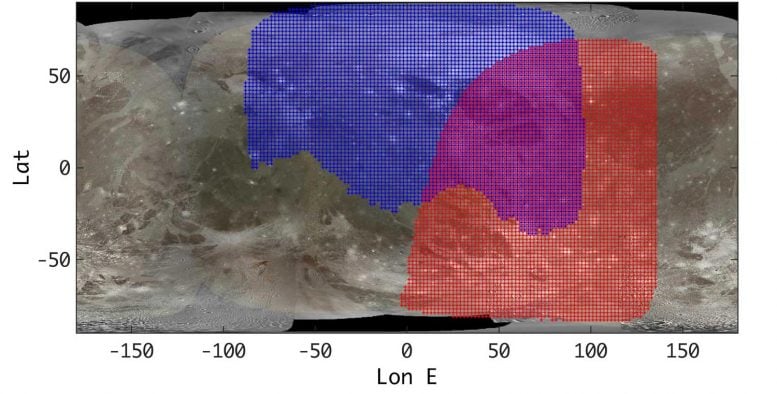This infrared view of Jupiter’s icy moon Ganymede was obtained by the Jovian Infrared Auroral Mapper (JIRAM) instrument aboard NASA’s Juno spacecraft during its July 20th, 2021, flyby. Credit: NASA/JPL-Caltech/SwRI/ASI/INAF/JIRAM
The spacecraft used its infrared instrument during recent flybys of
This annotated map of Ganymede depicts the areas of the Jovian moon’s surface that were imaged by the Juno spacecraft’s JIRAM instrument during two recent close approaches of the moon. Credit: NASA/JPL-Caltech/SwRI/ASI/INAF/JIRAM/USGS
Juno came within 31,136 miles (50,109 kilometers) of Ganymede, the solar system’s largest moon, on July 20, 2021. During earlier flybys on June 7, 2021, and December 26, 2019, the solar-powered orbiter came within 650 miles (1,046 kilometers) and 62,000 miles (100,000 kilometers), respectively. The three observational geometries provided an opportunity for JIRAM to see the moon’s north polar region for the first time, as well as compare the diversity in composition between the low and high latitudes.
Ganymede is also the only moon in the solar system with its own magnetic field. On Earth, the magnetic field provides a pathway for (function(d, s, id){
var js, fjs = d.getElementsByTagName(s)[0];
if (d.getElementById(id)) return;
js = d.createElement(s); js.id = id;
js.src = "https://connect.facebook.net/en_US/sdk.js#xfbml=1&version=v2.6";
fjs.parentNode.insertBefore(js, fjs);
}(document, 'script', 'facebook-jssdk'));
Read original article here
